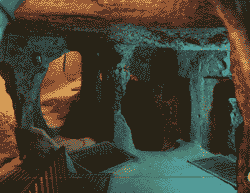
Ürgüp
Ürgüp which has been established at the outskirts of the hill named as hill of whishes founded at 20 km in north of Nevsehir province in one of the first settlement areas of Cappadocia region. In the Byzantine period has been called as Osiana, Hagios, Prokopios, in the period of Seljuks as Bashisar and in the period of Ottomans as Burgut Castle. Until the first years of the Republic was called Ürgüp. Ürgüp was the patriarchate center of the Cappadocia region. The Üzümlü Church, Cambazli Church and Sarica Church in Ortahisar which was one of the villages of Ürgüp are the oldest rock churches from the region. Furthermore and Tavsanli Church and Church of Saint Basileious are the spectacular places. Ürgüp which has got the famous cave hotels, wines and hand made carpets is the most important tourism center of the Cappaddocia Region. The old cave houses were restored as a touristy cave hotel without damaging their historic structure. Among the cave hotels some of the cave have been restores as distraction place as discos and bars.







